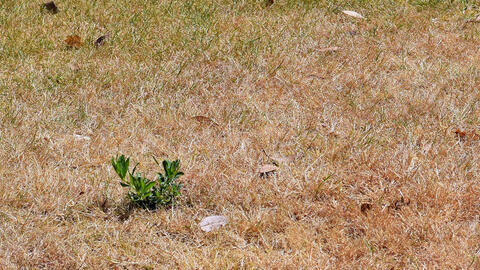Scorched lawn: Will it ever turn green again?
If you do not water your lawn regularly in dry heat, you will soon only find a yellow-brown steppe in your garden. Find out more as to whether your scorched lawn still has a future.

In hot and dry summers, a scorched lawn is a familiar sight in many places
Hot, dry summers leave clearly visible marks, especially on the lawn. The formerly green carpet "scorched": It turns increasingly yellow and finally looks dead. By now, many hobby gardeners are wondering whether their lawn will ever be green again or whether it is completely scorched and finally gone.
The reassuring answer is: Yes, it will recover. Basically, all lawn grasses are well adapted to summer drought, because their natural habitat is predominantly summer-dry, steppes and dry grass in full sun. If there were no periodic water shortages, sooner or later a forest would establish itself here and displace the sun-hungry grasses. The dried up leaves and stalks protect the grass from dying off completely. The roots remain intact and sprout again when there is enough moisture.

As early as 2008, the well-known lawn expert Dr. Harald Nonn conducted an experiment on how drought stress affects different lawn mixtures and how long it takes for the surfaces to regenerate after it is watered again. To do this, in the previous year, he sowed seven different seed mixtures in plastic containers with sandy soil and cultivated the samples under optimal conditions in the greenhouse until they had formed a closed turf after almost six months. After a saturating irrigation, all samples were kept dry for 21 days and only on the 22nd day at 10 millimeters per square meter. In order to document the scorching process, the color change of each seed mixture from green to yellow was photographed daily and evaluated with a RAL color analysis.
The seed mixtures had reached the stage of complete desiccation after 30 to 35 days, that is, no more leaf green parts were recognizable. From the 35th day, all three samples were finally irrigated again on a regular basis. The expert documented the regeneration process every three days, also using a RAL color analysis.
It was noticeable that the two lawn mixtures with a particularly high proportion of the two fescue species Festuca ovina and Festuca arundinacea recovered significantly faster than the other mixtures. They were 30 percent green again within 11 to 16 days. The regeneration of the other mixtures, however, took significantly longer. Summary: Due to the ever hotter summers, drought-resistant lawn mixtures will be more in demand in the future. For Harald Nonn, the fescue species mentioned are therefore an important addition in appropriate seed mixtures.

However, there is a disadvantage when you don’t water the lawn in summer and let the green carpet "scorch" regularly: Over time, the proportion of lawn weeds increases. With their deep taproot, species such as the dandelion still find sufficient moisture even after the leaves of the grass species have long since turned yellow. They use the time to spread out further in the lawn. For this reason, fans of the well-tended English lawn should water their green carpet in good time when it is dry.
When the burned lawn has recovered - with or without watering - it needs a special maintenance program to eliminate the effects of the summer drought stress. First, add a fall fertilizer to strengthen your green carpet. It supplies the regenerated grass with potassium and small amounts of nitrogen. The potassium acts as a natural antifreeze: It is stored in the cell sap and acts as a de-icing salt by lowering the freezing point of the liquid.
About two weeks after fertilization, you should dethatch the lawn, because the leaves and stalks that die in summer are deposited on the sward and can accelerate the formation of lawn thatch. If there are larger gaps in the sward after dethatching, it is best to re-sow the area with fresh lawn seeds using a spreader. They germinate before the onset of winter, ensure that the sward becomes dense again quickly and thus prevent moss and weeds from spreading unhindered. Important: If the fall is also very dry, you need to keep the reseeding evenly moist with a lawn sprinkler.
Our lawn care calendar shows you when which care measures are due - this is how your green carpet looks its best all the time. Simply enter your email address at the bottom of the page and download the lawn care calendar as a PDF document.



